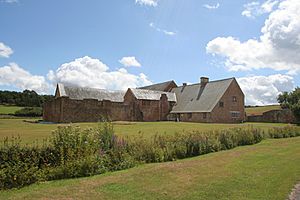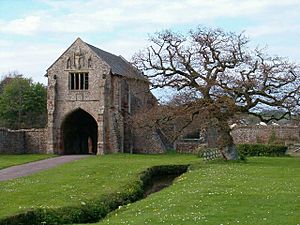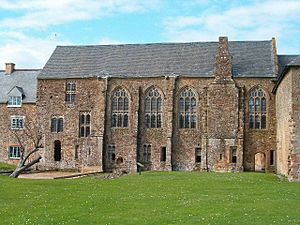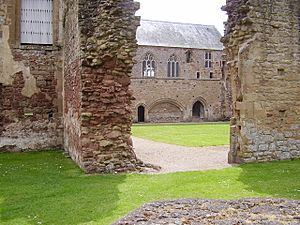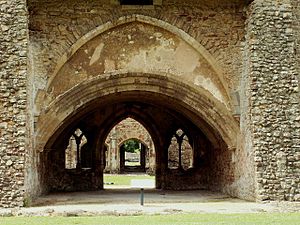Cleeve Abbey facts for kids

The Dormitory at Cleeve Abbey, viewed from the North-East
|
|
| Monastery information | |
|---|---|
| Full name | The Abbey Church of St Mary, Cleeve, Vallis Florida (Latin: 'Flowering Valley') |
| Order | Cistercian |
| Established | 1198 |
| Disestablished | 1537 |
| Mother house | Revesby Abbey |
| Dedicated to | Virgin Mary |
| Diocese | Bath and Wells |
| Controlled churches | Cleeve, Queen Camel, Woolavington and the chapel of Our Lady at Blue Anchor |
| People | |
| Founder(s) | William de Roumare, Earl of Lincoln |
| Important associated figures | John Hooper |
| Site | |
| Location | Washford, Somerset, England |
| Coordinates | 51°9′20″N 3°21′51″W / 51.15556°N 3.36417°W |
| Visible remains | complete cloister buildings in habitable state, church and infirmary are missing |
| Public access | yes (English Heritage) |
Cleeve Abbey is a fascinating medieval monastery located near the Washford River in Somerset, England. It's a very old and important building, protected as a Grade I listed building and an ancient monument.
This abbey was built in the late 1100s for Cistercian monks. These monks followed a strict way of life. For over 350 years, Cleeve Abbey was a home for these monks, though it sometimes faced challenges with money and management. One person from Cleeve, John Hooper, became a famous bishop but was later executed for his religious beliefs under Queen Mary I.
In 1536, King Henry VIII closed Cleeve Abbey during a time called the Dissolution of the Monasteries. The abbey buildings were then turned into a large country house. Over time, it became farm buildings. In the late 1800s, people started to protect and restore the abbey. Today, English Heritage looks after Cleeve Abbey, and you can visit it. It's one of the best-preserved medieval Cistercian sites in Britain! Even though the church is gone, many other buildings are still standing and have amazing features, like the "angel" roof and old wall paintings.
Contents
Building a New Home for Monks
Cleeve Abbey was started by a man named William de Roumare, Earl of Lincoln. On June 25, 1198, a group of 12 monks and their leader, Abbot Ralph, arrived from Revesby Abbey. They came to this spot to build their new home.
The abbey's official name was Vallis Florida, which means 'Flowering Valley' in Latin. But everyone usually called it Cleeve, after the nearby village. Other wealthy families, like the de Mohun and Beckerolles families, also gave land and money to help the abbey. They even had a special "Right of Wreck," meaning they could claim shipwrecks found on their lands.
Exploring the Abbey Buildings
Soon after the monks arrived, they began building their church. This took many years to complete. The church had a traditional design, shaped like a cross, with a long main hall (nave) and side chapels. The eastern parts of the church were likely finished by 1232. The rest was probably done by the middle of the 1200s.
South of the church was the cloister, a peaceful courtyard surrounded by the monks' living areas. The east side of the cloister was built first, around 1250. It held the chapter house (where monks met), the sacristy, the monks' dormitory (sleeping area), and a long reredorter (latrine).
The south side was built next. It included the kitchens, a warming house, and the refectory (dining hall). This dining hall stuck out from the main building, which was a common design for Cistercian abbeys.
The tiled floors in the refectory suggest it was finished in the late 1200s. These special encaustic tiles, about 23 cm square, showed the coats of arms of important people like King Henry III. They were likely made to celebrate a royal wedding in 1272. The last part to be built was the small west side, used for storage and for the lay brothers, who helped with farm work. East of the main buildings was another courtyard with the monks' infirmary (sick bay).
The monastery was next to the Washford River. It would have had gardens, fishponds, orchards, barns, guesthouses, stables, and other buildings. A moat filled with water and a gatehouse protected the abbey grounds.
Even though Cleeve wasn't a super rich abbey, the monks made big changes to their home. They wanted to keep up with the improving living standards of the later medieval period. In the 1300s, they added fancy, colorful tiled floors. In the mid-1400s, Abbot David Juyner completely rebuilt the south side of the monastery. He tore down the old dining hall and built a new, grand one on the first floor. This new hall had a beautiful wooden ceiling carved with angels! Below it, he built several small apartments, probably for people who paid to live at the abbey in their old age.
Abbot Juyner might also have added wall paintings with religious and story-telling pictures. Some of these paintings still exist today. One shows the Crucifixion, and another shows St Catherine and St Margaret with a man on a bridge, being attacked by a lion and a dragon. Building work continued right up until the abbey was closed. The gatehouse was updated after 1510, and the monks were even working on new cloister walkways in 1534. Sadly, this work was never finished because the abbey was closed down.
Life as a Monk at Cleeve
Like many smaller Cistercian abbeys, we don't know every detail about Cleeve's daily life. In its early years, the abbey received gifts of land and money from local lords and the King. It grew steadily in the 1200s, with 26 monks living there by 1297. The abbey owned several local churches and even had the right to collect income from the church on Lundy island. They also looked after a chapel for pilgrims near what is now Blue Anchor.
A big way the abbey made money was by selling wool. However, the 1300s brought tough times. The Black Death (a terrible plague), a struggling economy, and some poor management caused the number of monks to drop sharply. The abbey also fell into debt. There were even reports of some discipline problems within the community.
But things got better in the 1400s. Even with the expensive building projects, better management and new ways to earn money (like holding markets) helped the abbey. Just before it closed, Cleeve Abbey was enjoying a peaceful and stable time.
The Abbey Closes Down
In 1535, a survey of church finances showed Cleeve Abbey's income was £155. This meant it was one of the smaller monasteries that King Henry VIII decided to close. This was part of his plan called the Dissolution of the Monasteries.
Abbot William Dovell and his 16 monks were forced to give up the abbey on September 6, 1536. Some people, including local gentry, tried to save Cleeve Abbey, but it wasn't allowed. The monks finally left in the spring of 1537. Abbot William received a comfortable pension of 40 marks per year, which he was still getting 20 years later. Most of the other monks also received pensions.
One former monk, John Hooper, became very important. He became a bishop but was later killed in 1555 for his Protestant beliefs by Queen Mary I.
What Happened After?
After Cleeve Abbey became the King's property, it was rented out. In 1538, the land was given to Robert Radcliffe, 1st Earl of Sussex. The church was torn down, except for one wall that bordered the cloister. The rest of the abbey was turned into a large house for a wealthy gentleman.
However, by the early 1600s, Cleeve had become a farm. The monks' dormitory was now a big barn, and the cloister was used as a farmyard. The other buildings were used for farming and as a farmhouse.
In 1870, George Luttrell of Dunster Castle bought the site. The abbey stopped being a farm, and people started digging to find out more about its history. The farmhouse was turned into cottages for rent, and the site became a place for tourists to visit.
In 1950–51, Cleeve Abbey was given back to the Crown to pay taxes. The Department for the Environment then managed it. A lot of restoration and archaeological work was done. In 1984, English Heritage took over caring for Cleeve Abbey, and they still look after it today.
Cleeve Abbey Today
While the church and infirmary are mostly gone, Cleeve Abbey still has some of the best-preserved monks' living areas in southern England. The buildings around the cloister still have their roofs and many rooms keep their original arched ceilings.
Some of the most important rooms you can see are the chapter house, the refectory with its amazing wooden ceiling carved with angels, and the painted chamber with its old wall paintings. Much of the abbey's original medieval tiled flooring is also still there. Other important parts that remain include the abbey gatehouse, which you still walk through to enter, the moat, and the fishponds. Cleeve Abbey is open to everyone to explore and learn about its history.
The abbey buildings are recognized as a Grade I listed building and a Scheduled monument, meaning they are very important and protected.
See also
- List of monastic houses in Somerset
- Grade I listed buildings in West Somerset
- List of monastic houses in England


